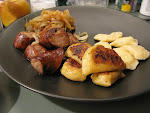Food is a very significant characteristic to any given society. Universally, food is very diverse and varies from culture to culture. Poland is well known for its range of food considering that some of the most common ingredients include cabbage, garlic, potatoes and turnips. Some Polish food, such as pierogis and kielbasa, resemble food from other countries, yet it calls for somewhat of an acquired taste. Polish deserts like babka and krushyki have distinctive tastes. All of these Polish dishes may either be homemade or bought at a Polish market. In fact, the nearest markets to Holliston are in Bellingham and in Worcester.
Pierogis most closely resemble ravioli but are more diverse. Like ravioli, pierogis are pasta folded over and have food within the fold. However, ravioli is typically limited to cheese and beeg fillings while pierogis may be filled with nearly anything. Some popular fillings include fruit, cheese and vegetables. For example, blueberry, potato and cabbage pierogis are especially familiar to the Polish diet. Fruit pierogis are most likely the sweetest filling and vegetable fillings vary in taste depending on the particular vegetable. Potato pierogis, for instance, taste bland when compared to the sweet taste of beet pierogis. Cabbage pierogis in particular are very bitter and perhaps even sour in taste. If one desired to make their own pierogis they would generally use unleavened dough, place it in a mold and stuff it with the filling of their choice. Pierogis are one of the most common staples of the Polish diet and also one of the best tasting foods.
Kielbasa is another favorite both in Poland and even here in the United States. However, kielbasa has a distinct taste and requires an acquired taste palate in order to be enjoyed. Kielbasa is analogous to sausage yet much more substantial. Often times, kielbasa has a strong odor about it to go along with its taste. Frequently the smell and taste lingers with you for the remainder of the day. Despite this, there’s nothing better than coming home to the smell of kielbasa cooking on the stove for dinner. Kielbasa is often made from pork and beef along with a variety of spices. In addition to its sharp aroma, many Poles enjoy their kielbasa with a side of horseradish or spicy brown mustard. To be on the safe side, I would try the kielbasa by itself before adding any horseradish that would really make your taste buds go untamed.
To top off a good meal you need a good desert. Babka is not a desert per se, but rather sweet bread. Babka is made with yeast, like most breads, and baked in a conventional oven. Babka can have virtually any ingredient in addition to the basic recipe. Additional ingredients can include fruits, spices, sour cream and nuts. Krushyki, a second favorite Polish desert, is like fried dough except crispier. Krushyki is covered in powdered sugar and is very sweet. Overall, these two dishes are very delectable and common in Poland from day to day, at all holidays and family gatherings.
Overall, I find Polish foods to be very appetizing and full of flavor. It surprises me how much variety there is in food when thought is put into it. Pierogis, kielbasa, babka and krushyki are only several of Poland’s unique dishes and they provide brief insight into the culture.
579
Subscribe to:
Post Comments (Atom)



Hey Nicole! I thought it was interesting that you dedicated your whole blog to Poland, so I was just wondering if you were Polish or something. Anyways, I enjoyed reading your blog, mainly since I learned a lot of things I would probably have never known. You did a good job detailing each food and what it was. However, I felt that it could have been a little less formal, though I'm not saying it is bad to go by the intro paragraph, three body pargraphs and concluding paragraph. Also, I know you explained what each food was and what it consisted of but I want to know more of why you like it. Other than that, I enjoyed reading your blog, since now you made me want to try all these different foods! Nice work!
ReplyDeleteYou've got a habit of writing inherently contradictory sentences. Look at this one: "Pierogis, kielbasa, babka and krushyki are only several of Poland’s unique dishes yet they provide a substantial insight into one of the most important factors in a society’s culture." The terms "several" and "unique" are opposed terms. If you can come up with several examples, how can they be unique?
ReplyDeleteHere's another: Polish deserts like babka and krushyki taste like any other desert but distinctive in its own way. There are three distinct things wrong with this sentence. What are they?
Watch out for insincere sounding sentences, too. If the foods "provide substantial insight into one of the most important factors in a society's culture", what's the insight? What's the factor? Aren't you really saying: "These foods are excellent representations of typical Polish cuisine." Why not simplify what you're writing, and be direct and efficient? Your writing will improve and you'll communicate more effectively.
Your expositional paragraph on pierogies was excellent, stressing the uniqueness of the pierogi when contrasted to the Italian ravioli.